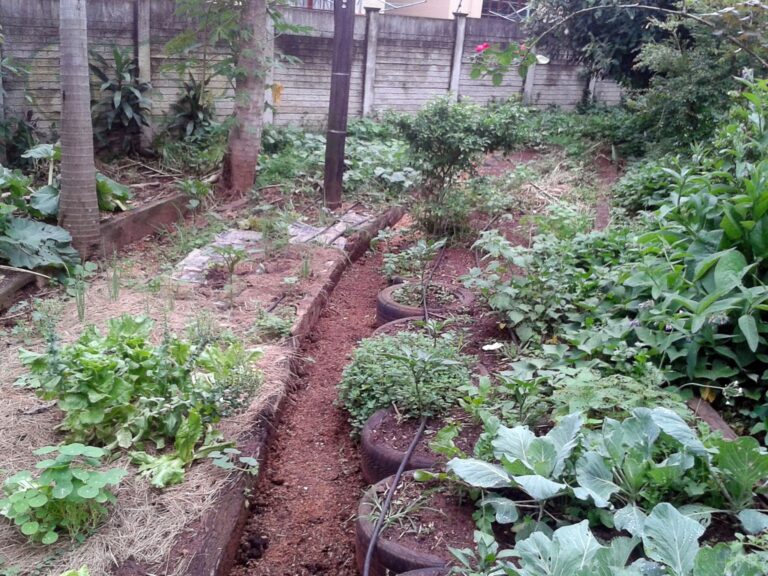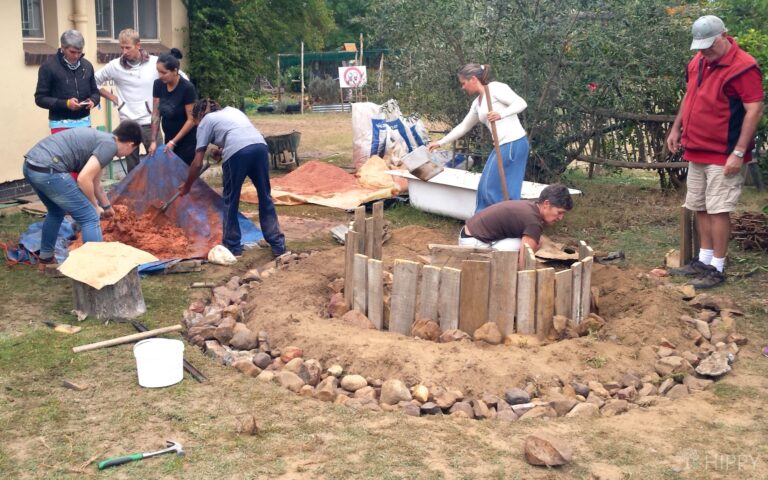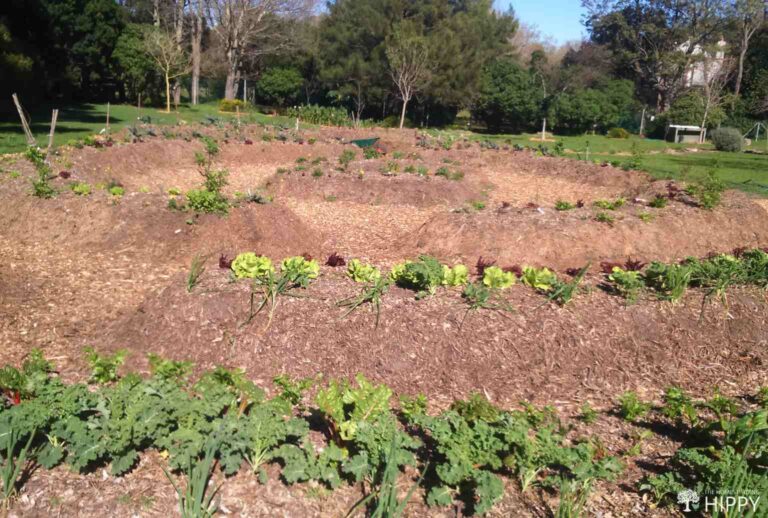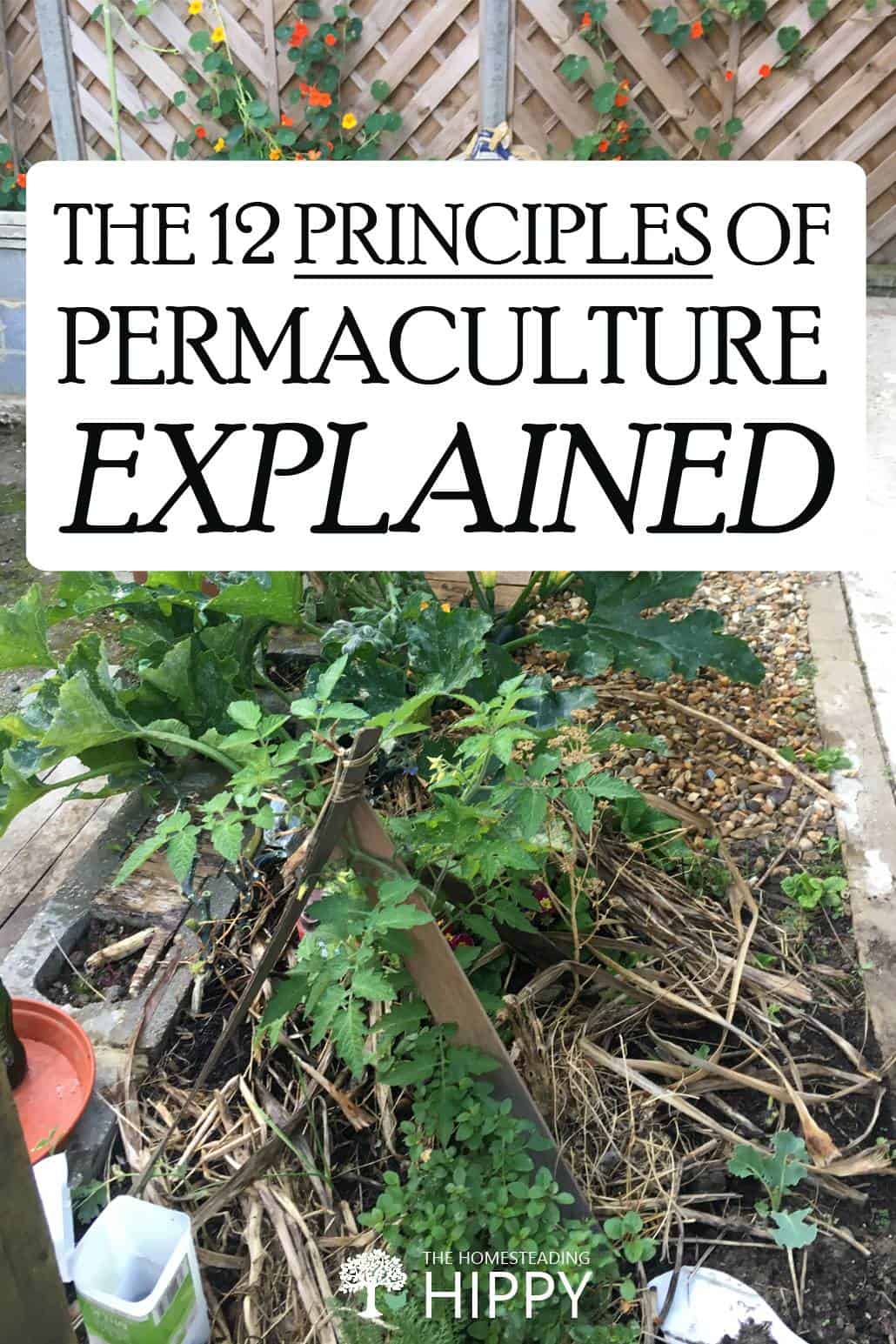Permaculture was first introduced as a concept in the 1970s by David Holmgren and Bill Mollison while the two were studying environmental design at a university in Australia.
Despite the fact that it is not a necessarily modern concept, many people have never heard of permaculture.

The idea behind permaculture is simple. Holmgren and Mollison were attempting to reconcile ecology, agriculture, and landscape design into one inclusive concept.
When investigating nature’s biodiversity, they asked why agriculture did not harness nature’s ability to create a system that was both sustainable and efficient.
From this thought process, they developed a blueprint not only for agriculture, but for personal, social, economic, and political reorganization.
The term “permaculture” comes from combining “permanent agriculture” and “permanent culture”.
Table of Contents
The Principles of Permaculture
The principles of permaculture consist of twelve core premises that can also be thought of as tools. The principles encourage us to evaluate, as individuals and society, how we live, work, and grow our food.
The twelve principles combine to develop a universal philosophy. This philosophy can be used to redesign how we think and behave with respect to the environment.
The concepts allow us to harness the natural elements of our environment, while also respecting and protecting our planet.
Permaculture is a truly integrated approach to life that is universal to ethnicity, religion, and country.
The ethos and philosophy of permaculture offer an alluring opportunity to develop a new communal existence that is reconciled with, rather than contradicting and going up against, nature.
The concept has inspired many around the world to set up communities outside of what might be considered established social norms to create a better life.
The concept of opting out of society is, in many ways, not new. Communities such as The Kibbutz setup in Israel in 1948 have enjoyed continuous growth.
Perhaps the early pioneers and today’s homesteaders, too, all yearn for that simpler, more natural existence as defined by permaculture.
Principle #1: Observe and Interact
Life can be hard – we struggle to meet the financial demands of our modern-day consumer-driven life.
Often, we’re in such a rush to get things done. Our lives are so busy trying to fit everything in that we do not see the broader implications of our actions.
How many times have we bought something on the spur of the moment to later discover it is not suitable for the task at hand?
How many times have we planted something in our garden to find that it is not compatible with our soil type? Too often we settle for that quick fix without looking at the bigger picture.
Observations take time. Too often, we only have in our mind the end result. We want those tomatoes to grow in this particular spot as it is a convenient location. We want that flower to grow in that particular spot because it will look good.
Permaculture suggests that we observe in a meaningful way. To achieve this, it is necessary to slow down.
We must change the way that we look at the landscape, listen and think about what we can see and hear around us. We should take what we can see locally and encompass the setting into the larger picture.
Only after we have seen the intricacies of our environment is it possible to plant those seeds in the right place. We are then able to interact with nature by using informed decisions.
Principle #2: Catch and Store Energy
For many who live in what today we would call a traditional residential home, there is no reason to think about energy.
Electricity, hot water, and heating are all instantly available with the flip of a switch. For those that live off-grid, there is an understanding that energy created by natural processes is more beneficial.
Solar panels, wind and water turbines, and even geothermal sources from deep underground can all produce abundant, and pretty much free electricity without any help from the power grid.
These alternative sources can provide us with power, but permaculture tells us that we should also look at what kinds of power we are using – and how much.
Do we need a television in each room of the house – or all those electrical gadgets in the kitchen or the workshop?
We see city streets lit up all night when there is no one around. Houses with large numbers of lights both inside and out are left on all night. Are they all necessary?
Power is wasted since we do not think of it. Lights can now be produced that require much less power, but what power is consumed in producing these products?
With permaculture, we ask if these products are really necessary, and whether this power is worth wasting. There are other ways in which we can harness and uses earth’s natural energy.
Storing food without using power can be achieved by using a root cellar. Similarly, when we store foods in cans and jars, we are also storing energy that can be used later.
You might even position a greenhouse on the south side of a building to harness the sun’s rays to help grow crops and even extend the growing season.
Grow trees on the south side of the house. These will offer shade from the sun in the summer, and keep your house cooler without using extra power. Because the leaves fall in the winter, the sun can reach the house to help to warm it, too.
Rainwater harvesting is an efficient irrigation method, and can supply water for flushing toilets and washing clothes.
Principle #3: Obtain a Yield
Nobody likes going to bed with an empty stomach so don’t underestimate the importance of food in your life. We all need a variety of foods to ensure that we have enough of the essentials for our bodies and minds to function.
However, food production is a huge contributor to our individual and global footprint. The earth is under extreme stress as it works to supply enough food for the entire population of the world.
Traditional methods of food production are being replaced by intensive large-scale production.
Science is being used to change nature, enabling yields to be increased. Many crops growing in the United States today have been genetically modified, though Europe doesn’t allow this practice.
Are these methods the right way to solve the problem, or are they purely creating larger problems that will need to be addressed in the future?
Permaculture tells us it is not purely a question of producing food no matter what. The consequences must be investigated and addressed.
We need to be able to supply food, but care must be taken to create a sufficient yield in a sustainable way that doesn’t harm the earth.
It would make sense to take a share in producing food at a local level, possibly reducing the enormous variety that we seem to demand. A homesteader will say yes, that is what we are doing, but is it possible for the millions who live in cities to embrace permaculture? Absolutely.
Principle #4: Apply Self-regulation and Accept Feedback
Our actions on a singular level have the potential to react globally. Our methods of productivity, both in producing food and other consumable goods, have a pronounced effect on the earth.
We can see that, by burning fossil fuels, we release substantial quantities of CO2 into the atmosphere every year.
This results in changes in the atmosphere, causing global temperatures to rise. With the reflective surfaces being reduced, more sunlight is absorbed, and even higher temperatures have been produced as a result.
We can see this process happening – so we should be able to regulate our actions to prevent the damage from becoming worse. But we don’t.
It goes even further. Chemicals have been used extensively, both to kill pests and to enhance crop production, in many countries.
We have often seen far too late that these chemicals can harm nature’s delicate balance. Often, chemicals are used excessively, resulting in them reaching and damaging the oceans.
There are alternatives to many of these chemicals. Permaculture would demand that we investigate these alternatives. Some insects feed on other insects that are harmful to our plants.
Sometimes, a container filled with sugar water tied to a tree is all it takes to eliminate certain harmful pests. Some plants planted in among crops will also deter harmful insects.
Traditionally, composted vegetable material and animal manure have been used to supply nitrogen to the soil to help us increase our yields.
It’s no longer enough to provide commercial growers with enough nitrogen, so now it’s being produced chemically from a different form of nitrogen that is found in the air. This source of nitrogen is vastly inferior.
This chemical process demands a huge amount of power. Can we not find sufficient natural manure?
Permaculture wants us to look at the vast quantities of a landfill that are being created from waste food and vegetation. It asks us if this waste cannot be used to produce the required manure.
Choosing to regulate our actions by reducing our energy consumption and lowering our waste is a form of self-regulation and feedback.
However, this self-regulation should not be placed solely in the remit of governments, individual actions can all have influence.
We are trapped in a cycle that seems impossible to break. We visit the store and buy a packet of cookies. Without a doubt, these cookies will be wrapped in two layers of plastic and possibly even a cardboard box.
We want to buy cookies the supplier wants to sell, and there is a need for them to be protected from external interference or contamination.
Permaculture requires us to see that the production of plastic is a problem and that we should regulate and change how we sell cookies.
People of a certain age will remember when cookies used to be sold loose in metal boxes. This allowed them to be sold in the quantities required, and wrapped in paper bags.
The metal box when emptied would be returned to be replenished. Yes, there is still a paper bag, but we have dropped the two plastic wrappers and the cardboard!

Principle #5: Use and Value Renewable Resources
What is permaculture referring to when it mentions renewable resources? To put it simply, a renewable resource doesn’t run out when repeatedly used.
There are five renewable energy resources:
- Solar energy
- Wind energy
- Hydro energy
- Tidal energy
- Geothermal energy
- Biomass energy
We have seen, all too clearly, that burning fossil fuels to create energy is no longer sustainable since our supplies are virtually exhausted. This practice also has a serious impact on the environment.
The use of renewable resources doesn’t only refer to energy. The way we construct our houses, and our cities also come under the permaculture spotlight.
These principles can guide us to alternative design and construction techniques. It would review where the property is built.
Does everyone need to live in a city? Current property construction techniques are inherently inefficient, resulting in buildings that lose a lot of energy, particularly when heating and cooling them.
Zero carbon footprint homes are starting to gain traction, and the good news is, these technologies still have a long way to go and be improved.
These principles would also affect agriculture, and lead to better soil conservation and the planting of different food crops with an emphasis on seed saving. The reliance on animals as a source of food would also change.
The progression should be towards renewable resources in all spheres. The principles tell us that we should look to these alternatives.
Permaculture requires society to embrace, rather than fear, change. The status quo does not have to always be the current way of doing things!
Principle #6: Produce No Waste
Permaculture says that we should produce no waste, however, is zero waste even possible?
Zero waste virtually impossible… let me explain why.
A simple visit to the store by one person results in a vast quantity of packaging, which at this time, is mostly produced by using nonrenewable resources.
One only must look at the problems being caused by the reliance on single-use plastic in such items as water bottles.
Permaculture requires every single product to be subject to different design and production techniques. It also requires us to decide if every single product we intend to purchase is ethical or even necessary.
The typical homestead will use and re-purpose as much as possible, and not rely on store-bought products.
Reducing our reliance on single-use products can have a great effect on the environment while requiring the least amount of change.
Some homesteads that are close to self-sufficiency will find that they are close to producing zero waste, but only after considerable frugality efforts and waste reduction repeated over time.

Principle #7: Design from Patterns to Details
From the principle of observation, we can use a bit of creativity to plan and design our projects from patterns to details.
The permaculture principle is that we do not start with the detail but rather the bigger picture (the pattern).
For example, if we are planning a garden or an area to be used for crop production it is vital to assess the properties that our land has before considering what types of seeds to sow:
- soil type,
- how much sun the area receives,
- its proclivity toward soil erosion,
- and whether it is likely to be invaded by pests.
The design can then advance to investigating techniques that can be used to produce crops. For example, the use of no-dig agriculture has great benefits.
Draw the plan on paper, starting from the outline and working through to the fine details. Have several plans so that the very best of the best can be selected.
We might draw a blueprint for the construction of a house; however, the permaculture plan would delve deeper into location, position, construction techniques, and materials. It would also consider how this particular property fits in with other properties nearby.
This allows us to use an ecological design that reduces our impact on the environment. A well-planned project will have the greatest effect on the environment.
Principle #8: Integrate – Do Not Segregate
We tend to plant gardens by separating vegetables from flowers. We typically think of the production of food and the aesthetics of a garden as separate.
Permaculture invites us to rethink this. Often, flowers planted with vegetables can help to reduce pests. This supplies a natural pesticide that will help improve the crop health and yield.
We should also reconsider plants we view as weeds. These plants, normally considered as a nuisance, have useful properties. Some have natural healing abilities, and many can be incorporated into our diets.
Permaculture says that rather than planting a monoculture of plants in neat rows we should consider growing multiple plants together so they help each-other out.
Permaculture would not suggest that we let what we classify as weeds grow wherever they want. Allowing free growth too close to crops can inhibit the quality of the crop.
There are, however, many areas that we don’t necessarily need to constantly keep these so-called weeds at bay.
Principle #9: Use Small and Slow Solutions
Permaculture recognizes that not all problems can be solved instantly, sometimes small steps over a period can produce the change to solve the problem. Permaculture dictates that we plan the changes in an effective structured way that takes place over a period – using smaller, more intensive systems.
For a homestead to become completely organic, it requires several years to become free of chemical additives. Just because it will take time to achieve this, it’s not a reason for delaying or not getting started at all.
A huge number of non-renewable resources are consumed every year by a food chain that transports food across thousands of miles to our supermarkets.
The solution to this is to grow food locally, within our community. This solution is not something that can happen overnight, however, starting this on a small scale can help on a path towards a global solution.
Principle #10: Use and Value Diversity
Permaculture principles tell us that we should embrace diversity. Diversity within our community and ecosystem is a goal that may at times seem impossible.
However, if we value something highly enough, we will do whatever is necessary to make it a reality.
We have seen how a polyculture can create diversity in the crops that we can grow. A planting of a diversity of crops prevents devastating situations that can arise from a crop failure.
This can happen – and unfortunately happens all too often – if we are only growing one plant. Crop diversity also provides a food source for many beneficial insects.
The world has many nations that have different cultures and ways of life that, throughout history, have led to many wars and violent campaigns. By investigating ancient history, it is possible to understand that everyone is related to common ancestry.
Principle #11: Use Edges and Value the Marginal
Edges in nature are typically where diversity and inter-relationships between the elements of the earth create truly special places. Permaculture says that we should recognize the value of these spaces and use these zones as much as possible.
Where we find the spaces in which the seas and rivers meet the land, there are the alluvial soils. These offer a naturally fertile environment that creates an abundance of wildlife and plants.
Some people live on the edge of our communities, where they find nature becomes a good friend.
Some people whom we refer to as “living on the edge of our society” are the free thinkers, the artists, the people who develop wisdom that defies time.
Non-democratic countries that demand that a strict set of rules be embraced by everyone, will typically radicalize those on the edges. However, these are the people that we should embrace and celebrate for their diversity.
Principle #12: Creatively Use and Respond to Change
Change is a natural process that permaculture suggests should be embraced and used to our benefit. Change can affect everything that we do within our society and agriculture.
Huge changes made overnight as an involuntary reaction to a problem will normally be unsuccessful. Change is feared by communities that are naturally suspicious of our present-day political leaders.
Gradual change allows communities to understand and invest in them, rather than feeling disenfranchised.
In this day and age, much of society tries to avoid inevitable change, since it can, at times, be difficult. Permaculture suggests that we should take a holistic approach and that in design, we should attempt to understand how all the different factors interact with each-other.
It is then possible to incorporate the changes into the design. Planting a tree in front of a solar panel array may be fine now, as it might not obscure the sun. However, what about in five years when the tree has grown?
If the tree obscures the sun, then we must either remove the tree, or move the panels. Best not to plant the tree in the first place.
Permaculture recommends that we should plan carefully and consider the changes that will happen from our actions. We can then see the benefits and avoid many of the problems that change could create.
It also says that as we see changes that are either within or out of our control, it is necessary to amend plans and react to them accordingly.
It’s futile to continue on a singular path just because it is easy to walk on. The path may be easy, however, it may very well lead to a cliff with a sheer drop.
Summary
We’ve seen that permaculture principles incorporate twelve processes that can be thought of as tools to be used to re-engineer or reinvent our society.
They all suggest that as tenants of the earth that we all work together in an all-encompassing community that recognizes the natural properties that the earth exhibits.
By working within the framework of permaculture, we should learn to use the natural process of the earth while learning the importance of protecting them.
In this way, it is possible to live a meaningful and fulfilling life without ruining the opportunity for future generations to benefit in the same way.
The permaculture way is admittedly not that easy – it involves massive changes in how we live, how we build our houses, how we garden, and how we feed ourselves.
The challenge that a permaculture designer faces is to prove and understand how all these factors interact in a landscape, a plot of land, and society as a whole.
Since these principles are worth coming back to again and again, I highly encourage you to pin this article to your Pinterest board for later.


Three years ago, I bought an off-grid Cortijo in a small valley in the Andalucian mountains. Although, perhaps the lifestyle is in my genes as my grandfather and his four brothers were Homesteaders in Alberta Canada in the 1900s.
The mountains of Spain are a difficult place to grow many of the flowers that I was used to in the UK. However, veggies grow well year-round. Peppers, tomatoes, potatoes, lettuce, cucumber, melons, and chard all fare well in the Mediterranean climate. Almond trees provide me with a cash crop of around 1 ton while still retaining some to make almond milk and flour.
Meet the rest of the Homesteading Hippy team here.
